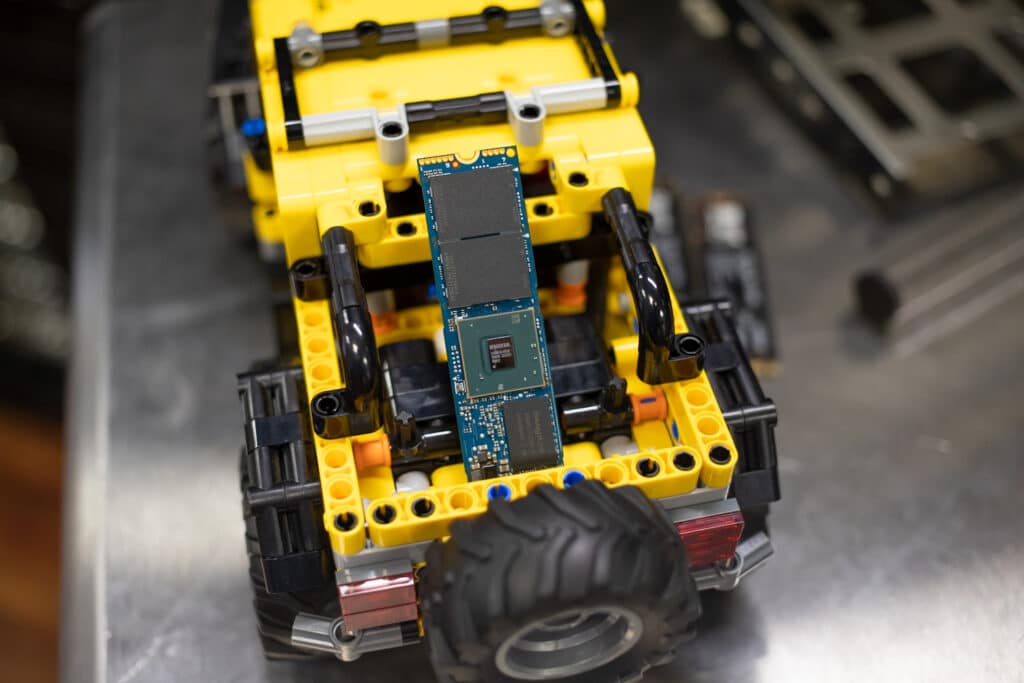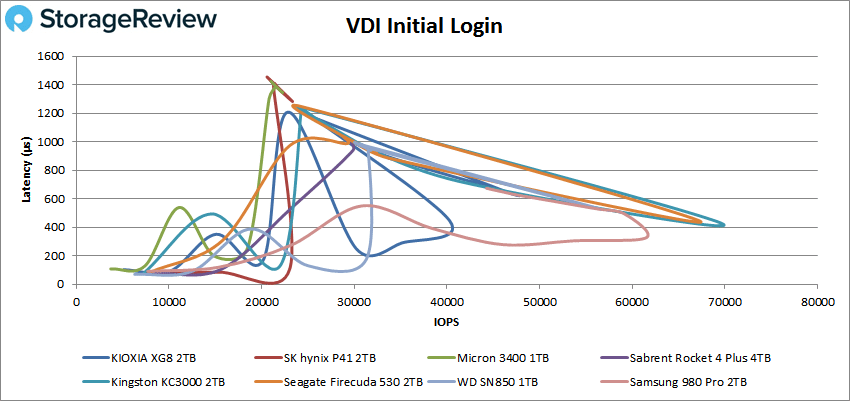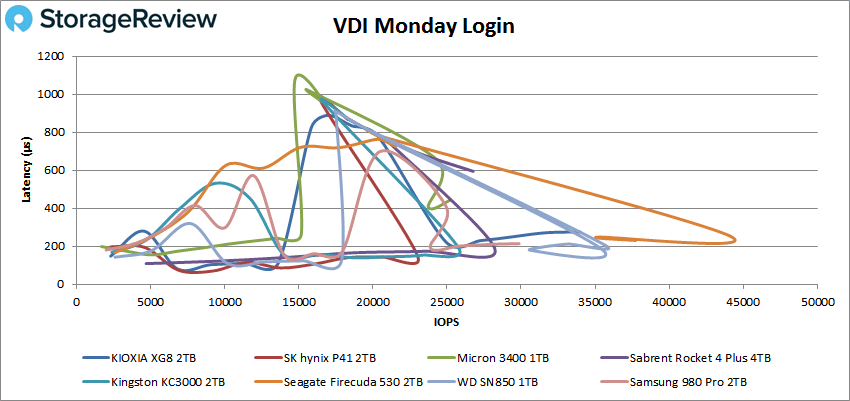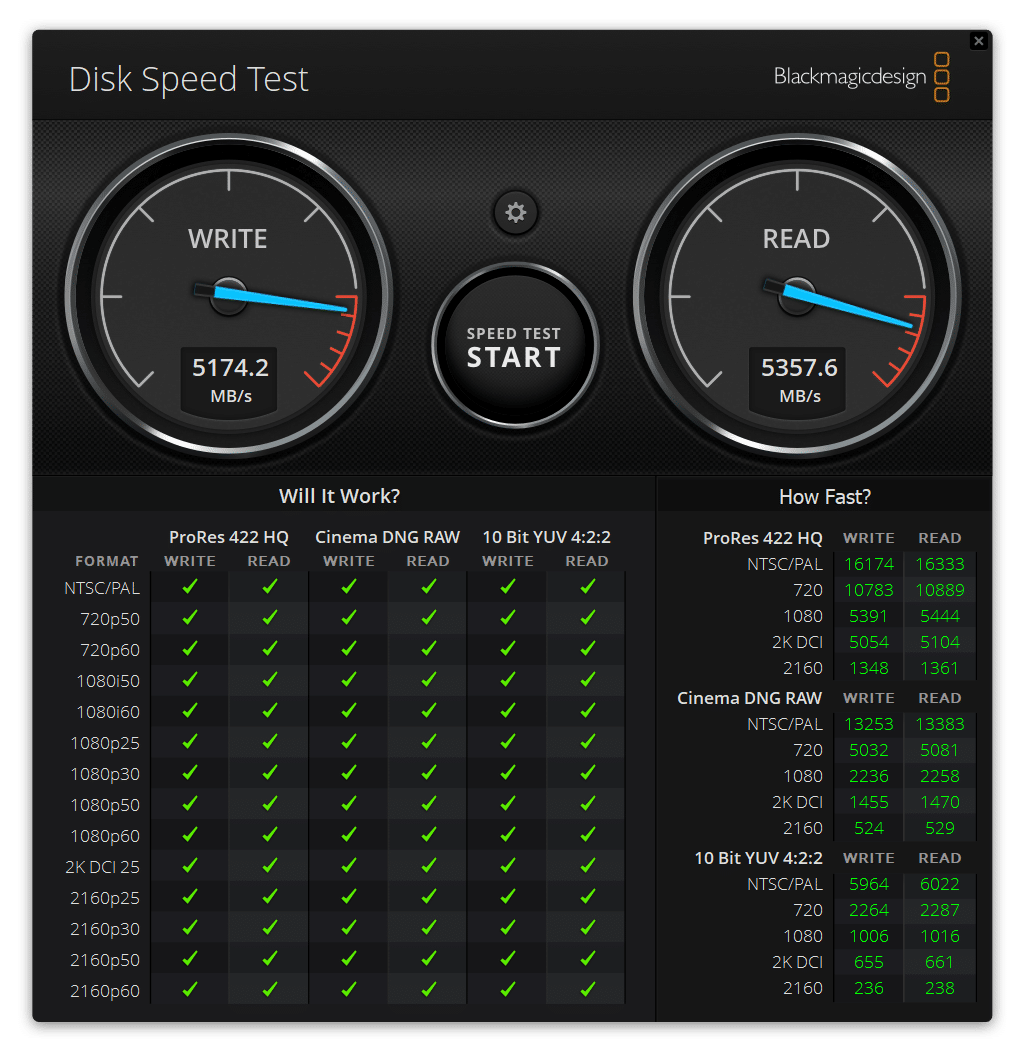The KIOXIA XG8 Series is a client SSD that leverages the PCIe Gen4 NVMe 1.4 specification and is a direct successor to the company’s XG6 series. Featuring 5th-gen BiCS FLASH 3D TLC NAND, KIOXIA is positioning the XG8 as a high-performance SSD for OEMs, giving system builders a viable option for workstations, gaming rigs, and even light data center applications (e.g., server-boot, caching and logging).
The KIOXIA XG8 Series is a client SSD that leverages the PCIe Gen4 NVMe 1.4 specification and is a direct successor to the company’s XG6 series. Featuring 5th-gen BiCS FLASH 3D TLC NAND, KIOXIA is positioning the XG8 as a high-performance SSD for OEMs, giving system builders a viable option for workstations, gaming rigs, and even light data center applications (e.g., server-boot, caching and logging).
 KIOXIA XG8 Series vs XG6/XG6-P Series
KIOXIA XG8 Series vs XG6/XG6-P Series
The XG8 is the second release in KIOXIA’s XG series. The biggest difference between the two Series is that the XG8 leverages the PCIe Gen4 interface versus the PCIe Gen3 in the XG6, which obviously means a significant difference in quoted performance:
| XG6/XG6-P Series | XG8 Series | |||||||
| Capacity | 256GB | 512GB | 1TB | 2TB | 512GB | 1TB | 2TB | 4TB |
| Sequential Read (MB/s) | 3,050 | 3,100 | 3,180 | 3,180 | 7,000 | 7,000 | 7,000 | 7,000 |
| Sequential Write (MB/s) | 1,550 | 2,800 | 2,960 | 2,920 | 5,000 | 5,600 | 5800 | 5,800 |
| Random Read (KIOPS) | 270 | 325 | 355 | 355 | 750 | 900 | 900 | 900 |
| Random Write (KIOPS) | 335 | 355 | 365 | 365 | 600 | 620 | 620 | 620 |
As you can see, all capacities are quoted to deliver up to 7GB/s in sequential reads, while potentially hitting up to 5.8GB/s in sequential writes. For random performance, the XG8 is expected to reach 900K IOPS read and 620K IOPS write. KIOXIA also upped the capacity to 4TB in the XG8 and they now use the 5th generation BiCS FLASH.
KIOXIA XG8 Series Features
The XG8 series is available in the standard M.2 type 2280 form factor and comes with a range of optional security features that use the latest TCG Pyrite 2.01 and TCG Opal 2.01 standards. Moreover, the XG8 Series is equipped with end-to-end data path protection and Power Loss Notification for improved data integrity and further peace of mind, helping to keep your files safe against both forced and unexpected shut-downs.
The XG8 Series also features power consumption of 8.1W (or less) while in active mode and less than 3mW in standby mode, the latter of which is noticeably less than drives like Kingston KC3000.
The 512GB – 2,048GB capacities are single-sided M.2 SSDs, while the 4TB model leverages a double-sided build.
The KIOXIA XG8 is available in capacities of 512GB, 1TB, 2TB and 4TB. We will be looking at the 2TB model for this review. Because KIOXIA has not mentioned warranty information for the drive, it will likely be associated with the host system it is being sold with. Also there is no street pricing as this is an OEM offering only.
KIOXIA XG8 Series Specifications
| NAND Type | 5th Gen utilizes KIOXIA 112-layer BiCS FLASH 3D flash | |||
| Drive Type | Client SSD | |||
| Form Factor | M.2 Type 2280
|
|||
| Interface | PCIe Gen4 (PCIe 16GT/s x4) | |||
| Capacities | 512GB | 1,024GB | 2,048GB | 4,096GB |
| Performance | ||||
| Sequential Read | 7,000MB/s | 7,000MB/s | 7,000MB/s | 7,000MB/s |
| Sequential Write | 5,000MB/s | 5,600MB/s | 5,800MB/s | 5,800MB/s |
| Random Read (IOPS) | 750K | 900K | 900K | 900K |
| Random Write (IOPS) | 600 K | 620K | 620K | 620K |
Testbed
As we migrate into testing newer NVMe Gen4 SSDs, it required a platform shift in our lab to support the newer interface. We’ve also been migrating newer NVMe Gen3 SSDs to the same platform for better apples-to-apples comparisons between drive generations. For these reviews, we leverage the Lenovo ThinkSystem SR635 server, equipped with an AMD 7742 CPU and 512GB of 3200Mhz DDR4 memory.
NVMe is tested natively through an M.2 to PCIe adapter card in the edge-card slot, while U.2 drives are loaded in the front. The methodology used better reflects end-user workflow with the consistency, scalability, and flexibility testing within virtualized server offers. A large focus is put on drive latency across the entire load range of the drive, not just at the smallest QD1 (Queue-Depth 1) levels. We do this because many of the common consumer benchmarks don’t adequately capture end-user workload profiles.
For our added BlackMagic Disk Speed Test performed in Windows, we use our self-built StorageReview desktop.
KIOXIA XG8 Performance
We are reviewing the 2TB version of the KIOXIA XG8 and will be comparing it to the following PCIe Gen4x4 drives:
- Micron 3400
- Kingston KC3000
- Sabrent Rocket 4 Plus (4TB) – Updated
- Samsung 980 Pro
- Seagate Firecuda 530
- Western Digital SN850
- Western Digital SN850x
- SK Hynix P41
SQL Server Performance
Each SQL Server VM is configured with two vDisks: 100GB volume for boot and a 500GB volume for the database and log files. From a system resource perspective, we configured each VM with 16 vCPUs, 64GB of DRAM and leveraged the LSI Logic SAS SCSI controller. While our Sysbench workloads tested previously saturated the platform in both storage I/O and capacity, the SQL test is looking for latency performance.
This test uses SQL Server 2014 running on Windows Server 2012 R2 guest VMs and is stressed by Quest’s Benchmark Factory for Databases. StorageReview’s Microsoft SQL Server OLTP testing protocol employs the current draft of the Transaction Processing Performance Council’s Benchmark C (TPC-C), an online transaction-processing benchmark that simulates the activities found in complex application environments.
The TPC-C benchmark comes closer than synthetic performance benchmarks to gauging the performance strengths and bottlenecks of storage infrastructure in database environments. Each instance of our SQL Server VM for this review uses a 333GB (1,500 scale) SQL Server database and measures the transactional performance and latency under a load of 15,000 virtual users.
SQL Server Testing Configuration (per VM)
- Windows Server 2012 R2
- Storage Footprint: 600GB allocated, 500GB used
- SQL Server 2014
-
- Database Size: 1,500 scale
- Virtual Client Load: 15,000
- RAM Buffer: 48GB
- Test Length: 3 hours
- 2.5 hours preconditioning
- 30 minutes sample period
Starting with SQL average latency, the KIOXIA XG8 posted a decent 5ms, which placed it in the middle part of the consumer NVMe SSD leaderboard.
VDBench Workload Analysis
When it comes to benchmarking storage devices, application testing is best, and synthetic testing comes in second place. While not a perfect representation of actual workloads, synthetic tests do help to baseline storage devices with a repeatability factor that makes it easy to do apples-to-apples comparison between competing solutions. These workloads offer a range of different testing profiles ranging from “four corners” tests, common database transfer size tests, to trace captures from different VDI environments.
All of these tests leverage the common vdBench workload generator, with a scripting engine to automate and capture results over a large compute testing cluster. This allows us to repeat the same workloads across a wide range of storage devices, including flash arrays and individual storage devices. Our testing process for these benchmarks fills the entire drive surface with data, then partitions a drive section equal to 1% of the drive capacity to simulate how the drive might respond to application workloads. This is different than full entropy tests which use 100% of the drive and take them into a steady state. As a result, these figures will reflect higher-sustained write speeds.
Profiles:
- 4K Random Read: 100% Read, 128 threads, 0-120% iorate
- 4K Random Write: 100% Write, 64 threads, 0-120% iorate
- 64K Sequential Read: 100% Read, 16 threads, 0-120% iorate
- 64K Sequential Write: 100% Write, 8 threads, 0-120% iorate
Starting with 4K random read, the KIOXIA XG8 showed a stable peak performance of 760K IOPS at 166.5 µs, which was good enough for 4th place and right behind the WD drives.
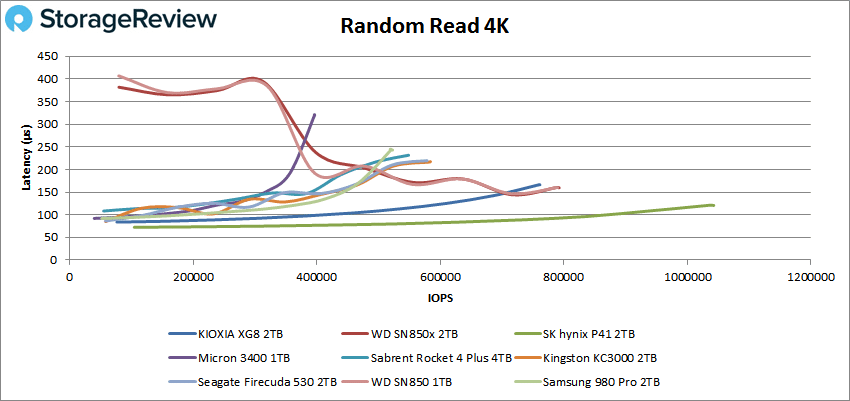
Moving onto sequential read 64K, the KIOXIA XG8 has solid results, peaking at 5.3GB/s (or 85K IOPS) with 377µs latency, which was among the top performing drives (though the Kingston SSD was far ahead).

Next, we looked at our VDI benchmarks, which are designed to tax the drives even further. These tests include Boot, Initial Login, and Monday Login. Starting with Boot, the KIOXIA XG8 had a peak of 170k IOPS with a latency of 210.3µs, which were solid results (placing 2nd).
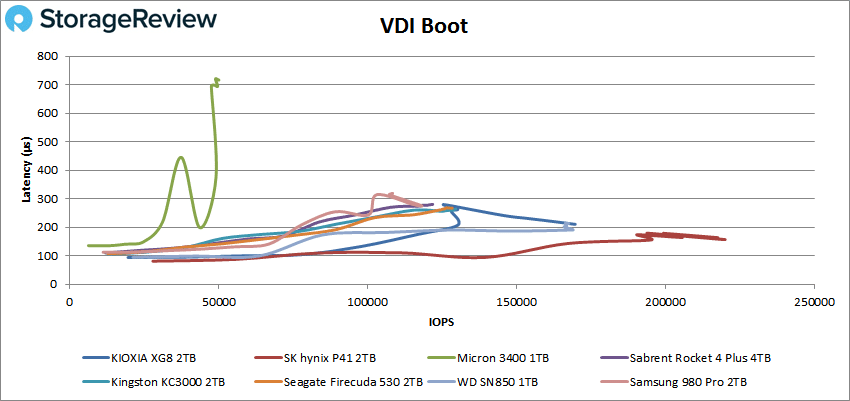
Finally, VDI Monday Login, where results were pretty tough to determine unless you had the source files like us. That said, the KIOXIA XG8 had solid results, peaking at 34k IOPS with a latency of 274.7µs before for 2nd place among the tested drives.
KIOXIA XG8 Blackmagic Performance
Lastly is our Blackmagic transfer speed test, where we measure transfer speeds inside our consumer test platform. Here the XG8 measured 5,357.6MB/s read and 5,174.2MB/s write.
Conclusion
The XG8 is another solid release from KIOXIA. Available in capacities up to 4TB and featuring 5th-gen 112-layer BiCS FLASH 3D NAND, this OEM Gen4 client SSD will find itself inside a range of gaming, content creation and professional systems. It also has important features to protect data against unexpected outages and shutdowns, such as end-to-end data path protection and Power Loss Notification.
As far as its performance goes, the KIOXIA XG8 produced great results and often found itself near the top part of the leaderboard in reads among the other TLC-based SSDs, though write speeds were a little below par. Specifics include 760K IOPS in 4K random reads, 245K IOPS in 4K random writes, and 5.3GB/s (or 85K IOPS) in sequential reads. It did show fairly weak sequential write performance with a peak of 1.1GB/s (or just 18K IOPS). It also had decent results in SQL server performance, posting 5ms in average latency.
Its solid performance continued during our VDI benchmarks, tests that tax the drives even further. With our Boot profile, the XG8 had a peak of 170K IOPS, while initial and Monday login tests topped out at 48K IOPS and 34K IOPS, respectively.
Overall, the KIOXIA XG8 is another good addition to the OEM market, posting above-average results in most of our tests, particularly in read performance. System builders will likely find that the XG8 is well-suited for more performance-driven (yet affordable) workstations and pre-built rigs with power efficiency in mind.
Engage with StorageReview
Newsletter | YouTube | Podcast iTunes/Spotify | Instagram | Twitter | Facebook | TikTok | RSS Feed


